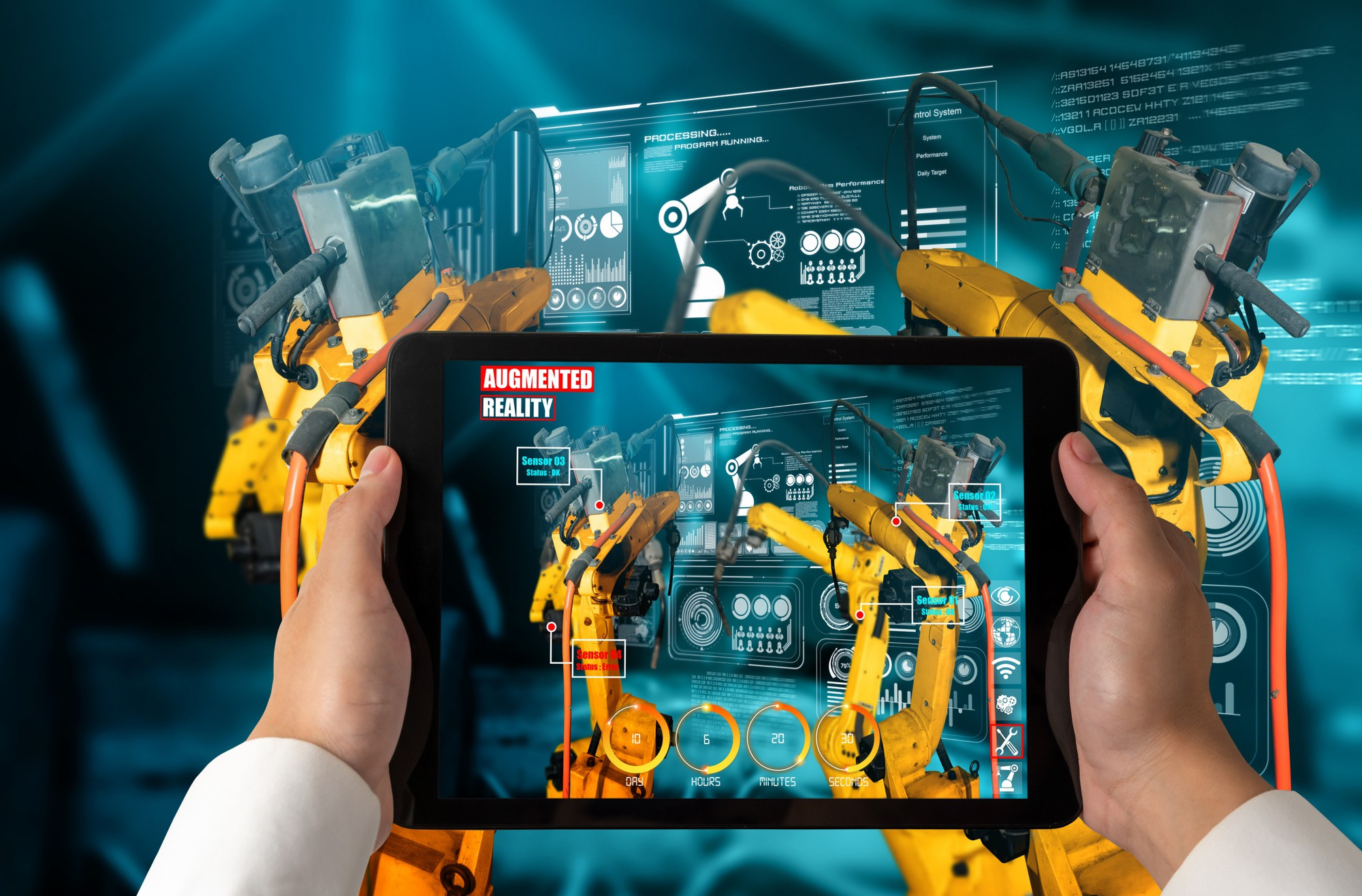Technology is transforming the way industries train their workforce, and Augmented Reality (AR) is at the forefront of this revolution. Once considered a futuristic concept, AR is now a practical tool that enhances training programs in manufacturing, construction, aviation, and many other industries. But why is AR gaining traction in industrial training? Let’s dive into this game-changing technology and explore its growing impact.
What is Augmented Reality (AR) in Industrial Training?
Augmented Reality (AR) is a transformative technology that overlays digital content such as images, instructions, and information onto the real world. This can be achieved through various devices, such as smart glasses, mobile apps, or AR headsets. Unlike Virtual Reality (VR), which immerses users in a completely virtual world, AR enhances the user’s interaction with their current environment by superimposing digital elements that can be seen and interacted with in real-time. This interaction between digital content and the real world offers a unique, dynamic learning experience.
In industrial training, AR is especially valuable because it allows employees to engage with complex machinery, equipment, or processes without the immediate risk of errors or accidents. For example, when learning how to operate a new machine, AR can project step-by-step instructions directly onto the machine’s surface or display troubleshooting guidance in real-time. This level of interactivity not only enhances the learning process but also ensures that employees receive precise and relevant information as they work, making the experience more intuitive and hands-on.
One of the main advantages of AR in industrial training is the ability to practice tasks in a controlled environment. By simulating real-world scenarios, AR enables trainees to develop skills and confidence without the fear of making costly mistakes. Whether it’s performing routine maintenance on equipment or assembling complex parts, employees can repeatedly practice these tasks until they feel comfortable, all while receiving immediate feedback. This hands-on approach to training has been shown to significantly improve retention and proficiency.
Moreover, AR facilitates immediate troubleshooting, which is particularly valuable in high-stakes industries such as manufacturing, aviation, or healthcare. If an employee encounters an issue with machinery or equipment, AR can offer interactive instructions, guiding them through diagnostic steps or suggesting corrective actions. This real-time support not only accelerates problem-solving but also minimizes downtime and reduces reliance on external expert intervention. AR’s ability to provide instant, context-specific information is a game-changer for industries looking to optimize their training processes.
Why is AR Gaining Popularity in Industrial Training?
The increasing adoption of AR in industrial training is driven by several factors:
- Improved Learning Retention: Hands-on learning with AR has been shown to increase information retention by up to 75%, compared to just 10% when learning through reading or listening. This dramatic improvement is due to the interactive nature of AR, which keeps trainees actively engaged in the learning process.
- Reduced Training Time: AR enhances the efficiency of training programs by providing clear, step-by-step guidance. This minimizes the time spent on instruction and accelerates the learning curve, allowing employees to become proficient more quickly.
- Lower Costs: Traditional training methods often rely on expensive physical resources, such as printed manuals, models, or machinery. With AR, the need for these materials is significantly reduced, cutting costs associated with their production and maintenance. Additionally, AR helps prevent costly mistakes by guiding trainees through the correct procedures, thereby reducing the likelihood of errors that could damage equipment or cause delays.
- Enhanced Safety: AR allows trainees to practice high-risk tasks in a virtual or controlled environment. For instance, workers can familiarize themselves with dangerous machinery or hazardous situations without putting themselves or others at risk. By practicing these tasks in a safe environment, they are better prepared for real-world scenarios, improving safety on the job.
- Remote Learning Capabilities: With AR, training can be conducted remotely, making it possible for employees to access educational content from anywhere in the world. This is particularly beneficial for industries with global workforces or those that operate in remote locations, allowing workers to receive consistent and high-quality training without needing to be physically present at a training center.
Key Applications of AR in Industrial Training
| Application | Purpose | Key Features | Benefits | Example |
| Equipment Operation Training | Safe training on complex machinery and industrial equipment | – Machine controls and functions – Step-by-step operation – Troubleshooting techniques | – Reduced risk of accidents – Increased operational confidence | AR overlays real-time guidance on assembly lines, teaching machine operation. |
| Maintenance and Repair Training | Interactive guidance for equipment repairs | – Visual overlays on malfunctioning parts – Repair instructions – Virtual repair simulations | – Decreases downtime – Boosts repair accuracy and efficiency | Boeing and Siemens use AR for aircraft maintenance, improving repair turnaround. |
| Safety Training and Hazard Recognition | Train workers to identify and handle workplace hazards | – Hazard identification in a virtual environment – Safety protocols – Emergency response practice | – Enhanced safety awareness – Reduced real-world accident risk | AR simulates fire emergencies in oil & gas, preparing workers for crisis situations. |
| Assembly and Manufacturing Training | Guide workers through detailed assembly tasks | – Step-by-step assembly guidance – Tool and component identification – Real-time error correction | – Reduces production errors – Streamlines assembly processes | BMW and General Electric use AR for assembly training, cutting production errors by 40%. |
| Remote Expert Assistance | Enable remote experts to assist workers in real-time | – AR smart glasses/tablets – Live video streams – Interactive annotations and guidance | – Reduces need for on-site experts – Accelerates problem-solving | AR enables remote expert assistance in aerospace and field service industries. |
| Soft Skills and Employee Onboarding | Immersive onboarding for new hires | – Virtual workplace tours – Collaboration exercises – Customer service training | – Engages new employees – Provides a better understanding of workplace dynamics | AR is used in retail and hospitality to onboard employees with interactive training. |
Best AR Technologies Used in Industrial Training
In industrial training, several AR technologies are being used to enhance the learning experience and improve efficiency. One of the most prominent AR technologies is AR smart glasses and headsets. These devices offer hands-free functionality, allowing workers to receive real-time guidance while keeping their hands free to operate machinery. For example, Microsoft HoloLens is commonly used in automotive and medical industries for hands-free training, enabling workers to interact with the environment while receiving visual instructions. Google Glass Enterprise Edition also assists workers by providing real-time, hands-free instructions, while Magic Leap takes it a step further by offering 3D interactive training simulations that immerse users in the task at hand, allowing for more dynamic learning.
Another widely used AR technology is AR mobile apps. Many industries use tablet-based AR applications to provide interactive guides and enable remote troubleshooting. These apps, such as PTC Vuforia, Scope AR, and TeamViewer Assist AR, allow workers to receive step-by-step instructions, perform repairs, or follow assembly procedures directly on their mobile devices. These apps offer portability and flexibility, ensuring that training can occur in various locations, and they make it easy for workers to access support when needed, even from remote areas.
Additionally, AR projection systems have become an important tool in industrial training. These systems project digital information onto physical surfaces, enabling workers to see instructional content overlaid onto the objects they are working on. AR projection systems are especially useful in environments like manufacturing plants, where workers must learn complex assembly tasks. By projecting instructions and visual aids directly onto the workspace, these systems reduce the need for wearable devices, making the training process more accessible and comfortable for workers. This technology allows for a seamless integration of digital training content with the physical world, making it easier to follow detailed instructions and ensure accuracy in the task at hand.
Challenges of Implementing AR in Industrial Training
Despite its numerous benefits, the adoption of AR in industrial training faces several challenges that can hinder its widespread implementation:
- High Initial Costs: One of the main barriers to AR adoption is the high initial investment required for AR hardware and software development. The cost of purchasing AR devices, such as smart glasses and headsets, along with the development of custom software, can be prohibitive for many companies. However, over time, the long-term savings in training costs, reduced errors, and increased efficiency often justify the initial investment, making it a worthwhile choice for many industries.
- Technical Limitations: Many AR devices rely on high computing power and a stable internet connection to function effectively. In industries located in remote areas or those with limited access to high-speed internet, implementing AR technology can be challenging. Additionally, AR systems may require substantial infrastructure upgrades, including faster networks and more advanced devices, which can add to the overall costs and complexity of deployment.
- Resistance to New Technology: Another challenge is the resistance to new technology, particularly among older employees who may be less comfortable with digital tools. Some workers may struggle to adapt to AR-based training methods, preferring traditional, non-digital approaches. Companies need to invest in change management strategies that focus on training employees to use these new technologies, ensuring that all workers are confident in their ability to engage with AR solutions.
- Content Development Challenges: AR training modules require highly customized content, which can be time-consuming and resource-intensive to create. Developing AR-based training involves collaborating with experts in areas like artificial intelligence (AI) and 3D modeling, as well as ensuring that the content is accurate, relevant, and effective. This process can be slow and costly, especially for industries that need to create large-scale training programs.
How Different Industries Are Using AR in Training
| Industry | AR Training Applications |
| Manufacturing | Assembly, machine operation, quality control |
| Healthcare | Surgery training, patient simulations |
| Aerospace | Aircraft maintenance, pilot training |
| Construction | Safety training, blueprint visualization |
| Automotive | Engine repair, assembly line guidance |
| Oil & Gas | Drilling simulations, hazard training |
The Future of AR in Industrial Training
The future of AR in industrial training looks incredibly promising, with the technology poised to revolutionize how industries train their workforce. The AR market in industrial training is expected to grow significantly, driven by a range of emerging trends that will further enhance its capabilities. One of the most exciting developments is the integration of AI-powered AR training. Artificial Intelligence (AI) will play a crucial role in making AR simulations more personalized and adaptive to individual users. AI can analyze the performance and progress of trainees, adjusting the training content in real-time to better meet their needs and learning pace. This personalized approach will ensure that workers receive the most relevant and effective training, boosting their retention and skill development.
Another key trend shaping the future of AR in industrial training is the rise of cloud-based AR solutions. Cloud technology will enable scalable, real-time training that can be accessed from anywhere in the world. This means that workers, regardless of their location, will be able to access AR training modules and resources without being limited by physical or geographic constraints. With cloud-based systems, companies can easily update training materials and provide consistent training across all locations, making it ideal for industries with a global workforce or those in remote areas.
The advent of 5G-enabled AR experiences will also significantly impact the future of AR in industrial training. With the enhanced speed and reliability of 5G networks, AR applications will experience faster data streaming and improved real-time collaboration. This will allow for more seamless, high-quality AR training experiences, especially in scenarios that require real-time interaction between remote experts and on-site workers. The combination of 5G and AR will enhance the overall efficiency and effectiveness of training, reducing latency and ensuring that trainees receive instant, high-quality feedback during their sessions.


